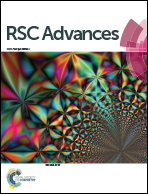Solid simultaneous saccharification and fermentation of rice straw for bioethanol production using nitrogen gas stripping
Abstract
Solid simultaneous saccharification and fermentation (SSSF) of rice straw for ethanol production using N2 stripping was developed. The effects of N2 flow rate, yeast inoculation amount, and substrate moisture content on SSSF were investigated. The highest total output of ethanol was 4.78 g, and the highest ethanol yield obtained was 56.3% using an N2 flow rate of 30 mL min−1, a yeast inoculation volume of 20 mL, and a moisture content of 4.6 mL (water) per g (substrate). The low residuals of ethanol and glucose in the substrate demonstrate that the N2 carrier gas effectively stripped the produced ethanol out of the packed bed, alleviating the inhibitions caused by evolved glucose and ethanol remaining in the bioreactor. With an increase in N2 flow rate or substrate moisture content, the total output of ethanol and ethanol yield initially increased and then decreased. However, with the increase in yeast inoculation volume, both indexes first rose and then remained relatively constant.


 Please wait while we load your content...
Please wait while we load your content...